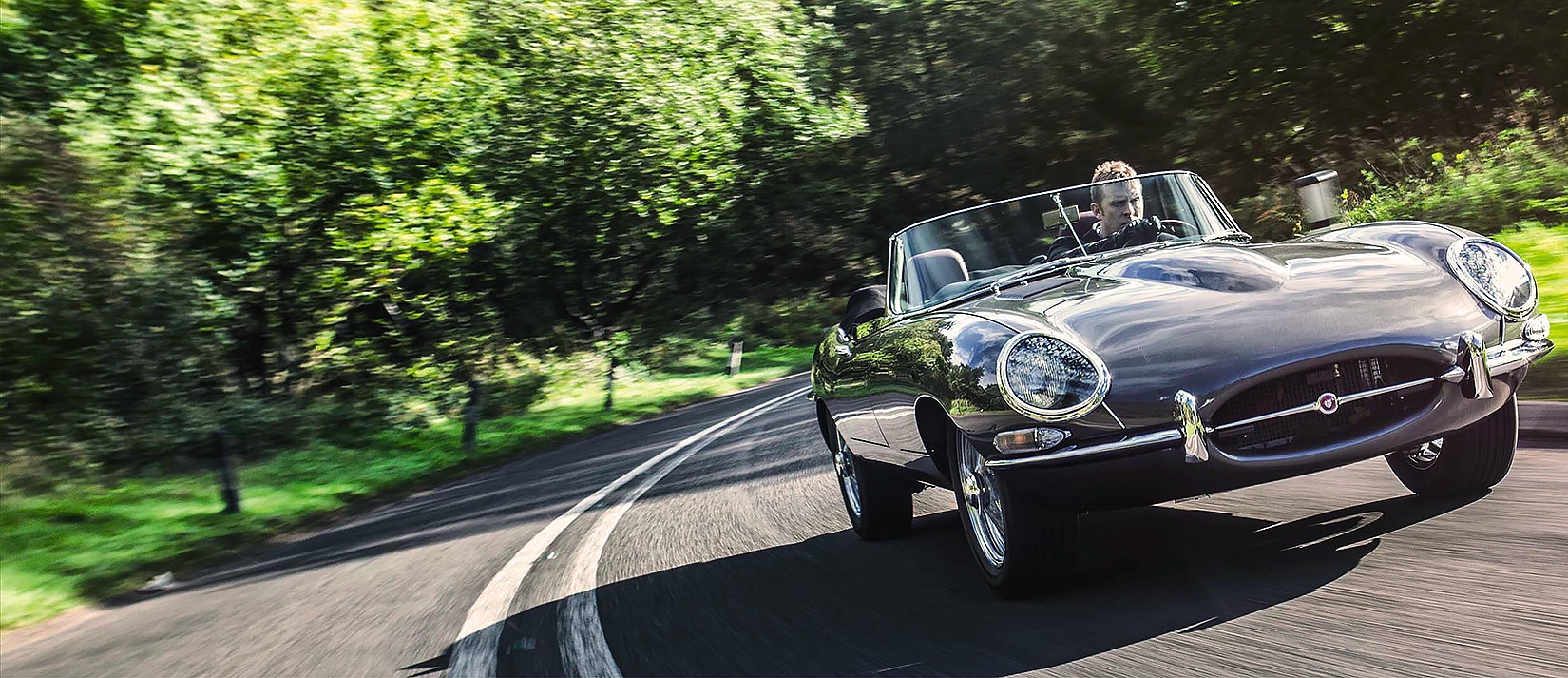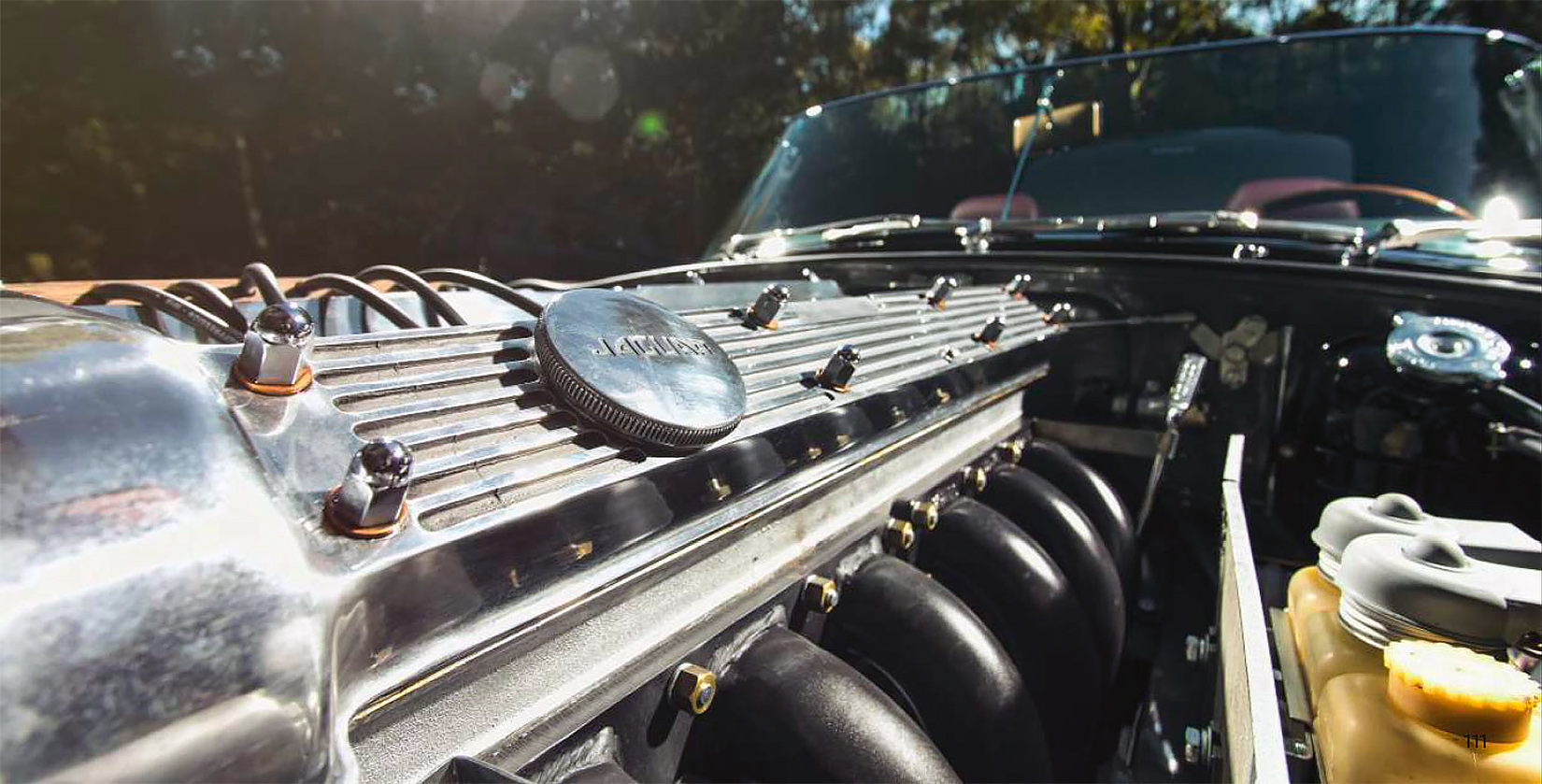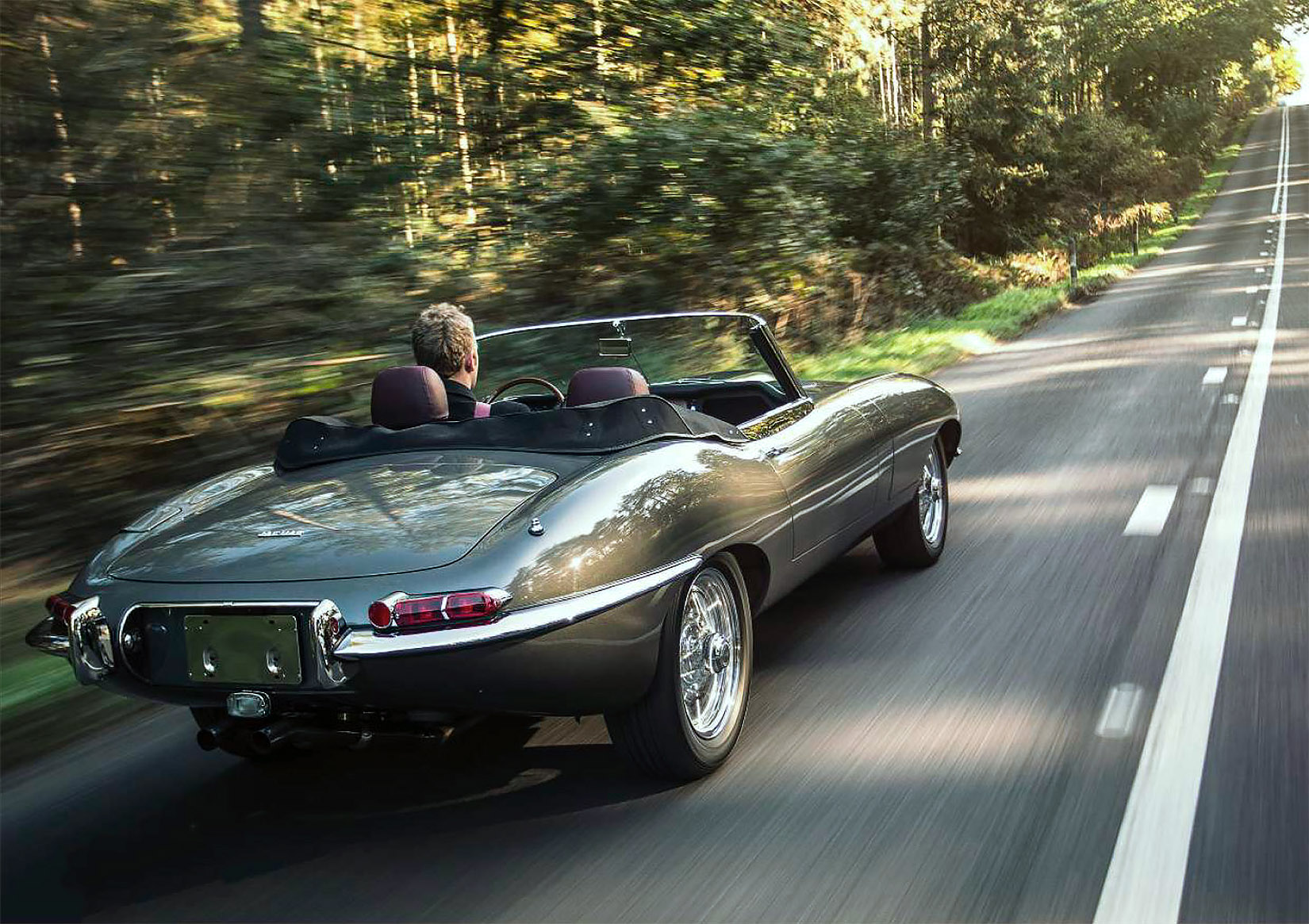
Japanese philosophy, British craftsmanship and American pioneer spirit come together to create a unique, stretched version of Jaguar’s all-time classic. Is it a success? Words: Nigel Boothman. Photography: Richard Pardon.
This is the first time I’ve been asked to write about a car purely because of my inside leg measurement. Never before has my role as the lanky one on the team picked me out for a particular job, but today I’ve been sent to drive a classic car purpose-built for someone like me. This handsome Opalescent Gunmetal E-type, though it may not appear so at first glance, has been stretched to accommodate a long-legged driver.
It’s the joint brainchild of a six-foot-tall American enthusiast, Paul Branstad, and Nick Goldthorp, managing director of Classic iMotor Cars (CMC) of Bridgnorth, Shropshire. CMC has huge experience in restoring special Jaguars, most famously the almost unbelievable feat of un-crumpling the poor Linder-Nocker low-drag E-type, which is now entirely finished after 5000 man-hours. Even so, Branstad’s challenging requirements were enough to give any restorer pause for thought.
Stretched E-type Japanese philosophy, British craftsmanship and American pioneer spirit merge to create a one-off version of Jaguar’s all-time classic.
He wanted a Series 1 car for its looks, stance, engine and everything else that makes the first-series E-type such a venerated classic. But he knew he couldn’t fit in one with any comfort, and he wanted a car for long driving tours across the US.
At first, the communication with Nick Goldthorp was by email but then Branstad crossed the Atlantic and came to visit. ‘He sat in each model, but felt too cramped in either a Series 1 or Series 2 E-type, and he didn’t like the aesthetics of the Series 3,’ says Goldthorp. ‘He eventually said, “I want an S1…how can we do it?” and I said, “Well, we can stretch one”.’

All the extra length is in the doors
Branstad didn’t want or need the storage behind the seats that a Series 3 has. So rather than putting an S1 on the S3’s wheelbase, which is nine inches longer, they decided to go halfway – four and a half inches would do it. But that wasn’t all. If the car could be stretched for generous legroom, could it also be made more spacious? Made easier, more relaxing, more comfortable and more reliable to drive on long tours? Could it incorporate modern conveniences like central locking and satnav? And could all this be achieved without spoiling the proportions or the character of one of the all-time classic sports cars?
Branstad pondered how such a car could have been created by its original designer (see panel) and in the course of this, a particular principle came to mind. The project became known as the ‘Kaizen E-type’, taking its name from one of Toyota’s founding principles, Kaizen, which translates as ‘understand the imperative to make continuous improvements and then get to work’.
‘It’s a good principle for any business,’ says Goldthorp. ‘It came up repeatedly as we found ways to improve the car. It was a collaborative process with Paul, who was engaged in every stage of it, always positive and ready to respond to a suggestion.’

Interior is a lot more spacious than an original E-type’s
The way CMC’s technicians approached the job is explained by Neil Pountney, the panel beater who had to decide where to cut. ‘The car was stripped and placed on our jig,’ he says, it had to stay standard from the gearbox crossmember forwards so all the mountings and mechanical parts could stay the same. The extra length was created by moving the chassis crossmember under the seats rearwards, stretching the floors, sills and doors, which all had to be custom-made. The crossmember was remade in thicker 16-gauge steel, like the outer sills, with inner-sill reinforcing pieces built in so the shell would be stiff enough.’ Straightforward? Not exactly.
‘The chassis rails on an E-type taper towards each other from front to back,’ says Pountney, ‘so when I came to trial-fit the new floors I found that there was going to be a minus dimension at the rear unless
I remounted both chassis rails at exactly the right angle.’ Bob Brooks dealt with the mechanical as peers of the job. We needed a custom propshaft, even though the Tremec five-speed gearbox is longer than a Moss box anyways he says, “The power steering system is a Ford rack, the right width to maintain the steering geometry and the brakes are four-piston calipers with vented discs at the front, and Series 3 V12-type calipers on vented discs at the rear.

Greater interior comfort means you can focus on enjoying the important bits, such as the moderately tuned engine
Air-conditioning and more powerful headlamps are supported by an alternator rather than a dynamo. More significant is the suspension – the new bodyshell is of course larger and (with extra fuel and modern accessories) 191kg heavier.
It’s much nicer in here. Even the pedals are better spaced, and I no longer have to put my size 12s behind the seat and drive in socks
‘We fitted stiffer rear springs to cope, says Brooks, ‘but also a stiffer anti-roll bar and stronger torsion bars at the front. The Koni Classic adjustable dampers allowed us to tune it all until we were happy.’
When I finally lay eyes on the car I walk round it to see just how noticeable the change is. Sure, you can tell, but considering the quantity of extra steel it’s remarkable how little obvious difference there is from standard. How long would it have taken me to notice if I didn’t know? We get a version of an answer from the admirers who come up to chat during the photoshoot. Not one of them spots any difference until it’s pointed out, and even then some of them seem to think I’m joking.
Part of this success is in getting the car’s stance right. It looks pert, light and fast, like a six-cylinder E-type should – not a long, hefty thing with its belly on the floor, like the more serpentine V12 roadster. The changes are a little more apparent with the hood up, and especially with the side window visible. All the extra length is in the door, which is instantly revealed when that large, long window is wound up. The window of a regular Series 1 or 2 is almost square by comparison. But enough chin- stroking. How does it drive?

To create an accurate frame of reference I’ve been for a few miles in a Series 1 E-type Roadster belonging to the brother of CMC owner Peter Neumark. It was restored nearly 20 years ago but still feels wonderfully taut and responsive, retaining all the bare-bones excitement of an early ‘E’ and everything that this brings with it: terrific steering but with some kickback as well as feedback, good brakes that seem a little too good when they grab under light pressure and of course a firm, tiring ride in a very’ snug cockpit. At least it’s driveable – a flat-floor E-type is impossible for anyone with long legs.
If getting into a Series 1 is a graceless experience, getting out with the roof up is akin to escaping from a straitjacket. Eventually I’m free and I hop into the Kaizen E-type before I’ve realised how much easier it is. The roof doesn’t touch my head, the seat is broad at both hip and shoulder, there is legroom to spare (Lord be praised) and the wheel slides miles closer when I loosen the adjusting collar. This leaves the indicator stalk a long way behind, but so what – it’s much nicer in here already. Even the pedals are better spaced, and I no longer have to put my size 12s behind the seat and drive in socks. The 4.2 engine flicks into life with a touch of choke and soon lopes along at a low, even tickover. The new diaphragm clutch is unexpectedly light but – uh-oh – the Tremec five-speed gearbox is hefty and obstructive. Is it attempting to imitate a worn Moss box, or is it just a little cold?
The latter. It improves remarkably after it’s warmed through, though I’m always aware of its weighty internal components.
I was concerned that the power steering would rob the Jaguar of its sports-car status, somehow reducing it to a boulevardier, but in an odd way it does the opposite. I’m carving through some fast B-roads, enjoying the broad spread of power and wonderful XK howl in the straights and cornering with enough verve to make it exciting, and it’s all ridiculously easy. That’s what this steering set-up does, in conjunction with a smoother, better-controlled ride, more progressive brakes and more relaxed driving position: it makes the sporting ability of the E-type instantly accessible.
Why should a sports car have to be difficult? Why should it require Fangio-like skill and balls of steel? Admittedly a standard E-type isn’t a vicious machine bur neither does it confer instant high-speed confidence like this one does. Point-to-point, this secure, planted feel makes the Kaizen E-type a faster car, not because it’s sneaked a few more horsepower from the mildly tuned 4.2-litre engine – the extra weight absorbs that – but because it can be driven at considerable speed with a minimum of nervous tension.
Is it perfect? No, not for me – but here we may get into the realms of personal preference on what is, after all, a bespoke suit of clothes for another man. Two height- related problems are still apparent. Firstly, the seat may be slimmer and lower, but not by much. Lowering the whole floor would mean relocating a crossmember but also encroaching into the area of the rear suspension mounts. Sadly, it leaves the windscreen rail right in my eye line, so either I slump down and look under the rail or sit up and look over it.
The taller roof highlights another issue. The seats, which are CMC’s own design, are a convincing compromise between modern ergonomic comfort and period looks, but the headrest only reaches the top of my neck. When and if my head jerks back, it strikes a piece of steel roof frame. The cure for this, of course, is to leave the roof down. Which at the owner’s Arizona home, you probably can.
Would the proportions be ruined by a taller screen? I find it impossible to say but if this were my wonderful one-off, I’d have to try it. Speaking of wonderful one-offs, the retro-looking Becker Mexico satellite radio satnav and the hidden radar detector under the ashtray are great fun, but nothing compared to the trailer. Neil Pountney describes how it was done. ‘We started with a trailer axle on a jig and mocked up rear quarter panels around it.
‘We found a centreline, made one-off panels for the internal structure and then used SI panels at the rear to match the car’s numberplate aperture and S2 panels at the front, which gives the trailer a slightly sharper nose. We had to modify the axle to take Jaguar splined hubs.
‘Paul said he needed to be able to tow the trailer at 80mph to get past trucks on certain highways, so could we test it at that speed? Not on the road we couldn’t. We hired Bruntingthorpe proving ground and it towed steady as a rock right up to 85mph.’
CMC created a superbly thought-out hidden towball. When required, it’s inserted into an aperture behind the reversing lamp and secured with a sturdy pin inside the boot. To take this loading, the boot floor has been totally re-engineered; first dropped by two inches to allow a larger 20-gallon fuel tank but also given a 16-gauge channel to contain the towball. This channel bolts through a new crossmember at the rear that ties the whole structure to the extended chassis rails. Conceive the improvement, then make it work.
Work they did, for 18 months and a cost that far exceeds a normal restoration.
Asking if that cost is worthwhile is probably the wrong question: if you want a perfect version of a car that is manifestly imperfect for you in standard form, and you can afford it, why not go for it? Let some wily craftsmen loose and see where it goes.
Any apparent shortcomings I found are personal, and could be down to something as simple as having a longer spine than the owner. There’s also this: at some point you have to accept that no amount of fiddling and fettling will stop it being an old sports car, but if you want it to have real character, that’s a good thing.
Both the Series 1 roadster and the Kaizen E-type look, sound and smell like old cars, but the Kaizen no longer feels like one behind the wheel. It’s become something else; not a modern super-classic like the Eagle E-type but the same old animal, somehow tamed and trained. It fits precisely with Paul Branstad’s dream of what the Series 2 and 3 should have been.
To build an E-type that doesn’t feel old, despite about 85 per cent of its technology being 50 years old or more, is quite an achievement, and one that lives up to the Kaizen objective perfectly. It’s not just the looks that are subtle and well-judged, it’s every single thing on the car. Now, how will you have yours done?
What’s your view on these modifications? Let us know. Amazing one-off trailer has Series 1 rear panels, Series 2 at the front.
THE MAN BEHIND THE MISSION
Who is responsible Paul Branstad or Malcolm Sayer, the E-type’s original designer? Yes, Paul is the instigator of the project, but he’s created an account of how the car could have been built in real life.
‘It’s a conceit of the imagination,’ he says. I wanted to think how Malcolm Sayer would have developed the E-type if he’d studied a Japanese firm like Toyota, and if he’d had the freedom to put these ideas into practice had Jaguar avoided merging into British Leyland.
Sayer’s early death at 54 in 1970 adds to the ‘what if’ aspect, but Branstad’s logic is easy to follow: the designer surely hated the changes made to the Series 2 in the name of BL’s cost-cutting. So let’s take the car forward using improvements to every aspect, and hang the cost. ‘The Kaizen E-type retains the 50:50 weight distribution,’ says Branstad. ‘It’s torsionally stiffer than before, the brakes are better, it’s more powerful, more comfortable, more flexible – it’s now a better sports car but also the perfect touring car, barring the luggage space, and the trailer takes care of that.’ Branstad, who was at school in the UK when the E-type was launched, has had several decades to dream the dream and he’s loved the process of turning it into reality. He’s almost sad the build is over; for some a nerve-racking experience. I never lost a night’s sleep – it was nothing but fun for me. Pure joy.’
|
Car
|
1968 Jaguar E-Type series 1 4.2 Roadster by CMC (standard 4.2 Roadster in square brackets) |
| Sold/number built |
1968 |
| Construction |
steel monocoque with tubular front subframe |
| Engine |
Engine 4235cc in-line six, double overhead camshaft, three SU sidedraught carburettors |
| Max power |
285bhp @ 5200rpm (265bhp @ 5400rpm) |
| Max torque |
298lb ft@ 3000rpm (283lb ft @ 4000rpm) |
| Transmission |
Five-speed manual (four-speed manual) |
| Drive |
rear-wheel drive |
| Suspension: | |
| front |
independent by double wishbones, torsion bars, adjustable telescopic dampers (non-adjustable), anti-roll bar |
| rear |
independent by lower wishbones, driveshafts, coil springs, adjustable telescopic dampers (non-adjustable) |
| Steering | Rack and pinion |
| Brakes |
Brakes Vented (non-vented) discs, servo-assisted |
| Wheels | – |
| Length | 4563mm (4453mm 14ft 7in ) |
| Width | 5ft 5 1/2in (1660mm) |
| Height |
3ft 11in (1190mm) |
| Wheelbase | 2550mm (8ft 2440mm) |
| Weight |
1484kg/3271lb (1293kg/2848lb) |
| 0-62mph |
7.3 secs (7.4 secs) |
| Top speed |
145mph (141 mph) |
| Mpg | 23(20) |
| Price new (1966) | £2245 |
| Price now (2014) | £60,000 |





